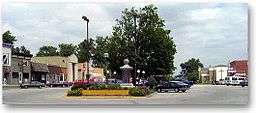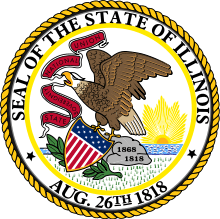Durand, Illinois
| Durand | |
| Village | |
 Downtown Durand | |
| Official name: Village of Durand | |
| Nickname: Village of Volunteers | |
| Country | United States |
|---|---|
| State | Illinois |
| County | Winnebago |
| Township | Durand |
| River | Otter Creek |
| Elevation | 778 ft (237 m) [1] |
| Coordinates | 42°26′02″N 89°19′41″W / 42.43389°N 89.32806°WCoordinates: 42°26′02″N 89°19′41″W / 42.43389°N 89.32806°W |
| Area | 0.94 sq mi (2 km2) |
| - land | 0.94 sq mi (2 km2) |
| - water | 0.00 sq mi (0 km2) |
| Population | 1,443 (2010) |
| Density | 1,200.9/sq mi (464/km2) |
| Village President | Gary Haughton |
| Timezone | CST (UTC-6) |
| - summer (DST) | CDT (UTC-5) |
| Postal code | 61024 |
| Area code | 815 |
| FIPS code | 17-21280 |
| GNIS ID(s) | 407516, 2398762 |
 Location in Winnebago County and the state of Illinois. | |
| Wikimedia Commons: Durand, Illinois | |
| Website: www | |
Durand is a village in Winnebago County, Illinois, United States. It is part of the Rockford, Illinois Metropolitan Statistical Area The population was 1,443 at the 2010 census, up from 1,081 in 2000.
History
Its township's beginnings initiated originally in a no longer existing settlement called Elton, an area South of Durand and including parts of the Pecatonica and Rock Run townships and settled in 1835 by Nelson Salisbury, Harvey Lower, and Scott Robb. They and nine other families settled the Southwest portion of modern Durand, Pecatonica, and Rock Run area. Durand gave birth to Illinois' first tax-supported volunteer fire department. Since its settlement, Durand has been prone to devastating fires.[2] Durand's early flourishings were closely linked to the development of the Racine-Mississippi Railroad later absorbed into Western Union.[3] The line reached Durand in 1857, en route to Freeport, paving the shift from the Elton community into modern Durand and deriving its name from the railroad's first president, H.S. Durand. At this time, Durand saw the beginning of its prosperity which entailed the demise of the Elton settlement.[4]
Geography
Durand is located at 42°26′2″N 89°19′41″W / 42.43389°N 89.32806°W (42.433928, -89.328007).[5] It is located 14 miles by road north of ![]() US Route 20 on
US Route 20 on ![]() Illinois Route 70.
Illinois Route 70. ![]() Illinois Route 75 also runs south of town.
Illinois Route 75 also runs south of town.
According to the 2010 census, Durand has a total area of 0.94 square miles (2.43 km2), all land.[6]
Demographics
| Historical population | |||
|---|---|---|---|
| Census | Pop. | %± | |
| 1880 | 530 | — | |
| 1890 | 489 | −7.7% | |
| 1900 | 571 | 16.8% | |
| 1910 | 527 | −7.7% | |
| 1920 | 549 | 4.2% | |
| 1930 | 554 | 0.9% | |
| 1940 | 592 | 6.9% | |
| 1950 | 679 | 14.7% | |
| 1960 | 797 | 17.4% | |
| 1970 | 972 | 22.0% | |
| 1980 | 1,073 | 10.4% | |
| 1990 | 1,100 | 2.5% | |
| 2000 | 1,081 | −1.7% | |
| 2010 | 1,443 | 33.5% | |
| Est. 2015 | 1,409 | [7] | −2.4% |
As of the census[9] of 2000, there were 1,081 people, 441 households, and 288 families residing in the village. The population density was 1,200.9 people per square mile (463.8/km²). There were 468 housing units at an average density of 519.9 per square mile (200.8/km²). The racial makeup of the village was 97.22% White, 0.56% African American, 0.28% Native American, 0.09% Pacific Islander, 0.65% from other races, and 1.20% from two or more races. Hispanic or Latino of any race were 1.02% of the population.
There were 441 households out of which 34.9% had children under the age of 18 living with them, 53.1% were married couples living together, 9.5% had a female householder with no husband present, and 34.5% were non-families. 32.2% of all households were made up of individuals and 15.6% had someone living alone who was 65 years of age or older. The average household size was 2.45 and the average family size was 3.10.
In the village the population was spread out with 28.9% under the age of 18, 6.9% from 18 to 24, 28.8% from 25 to 44, 21.8% from 45 to 64, and 13.6% who were 65 years of age or older. The median age was 36 years. For every 100 females there were 92.0 males. For every 100 females age 18 and over, there were 86.7 males.
The median income for a household in the village was $43,988, and the median income for a family was $51,042. Males had a median income of $41,016 versus $23,068 for females. The per capita income for the village was $19,211. About 5.5% of families and 5.6% of the population were below the poverty line, including 5.1% of those under age 18 and 8.4% of those age 65 or over.
References
- ↑ "Newtown". Geographic Names Information System. United States Geological Survey. Retrieved 2007-10-21.
- ↑ Nelson, C. Hal (January 1, 1968). "Sinnissippi Saga: A History of Rockford and Winnebago County, Illinois". Winnebago.
- ↑ Grant, H. Roger (December 4, 1996). The North Western: A History of the Chicago & North Western Railway System (first ed.). Dekalb, Illinois: Northern Illinois University Press, First Edition. ISBN 0875802141.
- ↑ Church, Charles A. (August 1, 2013). "Past and Present of the City of Rockford and Winnebago County Illinois". Repressed Publishing.
- ↑ "US Gazetteer files: 2010, 2000, and 1990". United States Census Bureau. 2011-02-12. Retrieved 2011-04-23.
- ↑ "G001 - Geographic Identifiers - 2010 Census Summary File 1". United States Census Bureau. Retrieved 2015-08-02.
- ↑ "Annual Estimates of the Resident Population for Incorporated Places: April 1, 2010 to July 1, 2015". Retrieved July 2, 2016.
- ↑ "Census of Population and Housing". Census.gov. Retrieved June 4, 2015.
- ↑ "American FactFinder". United States Census Bureau. Retrieved 2008-01-31.
